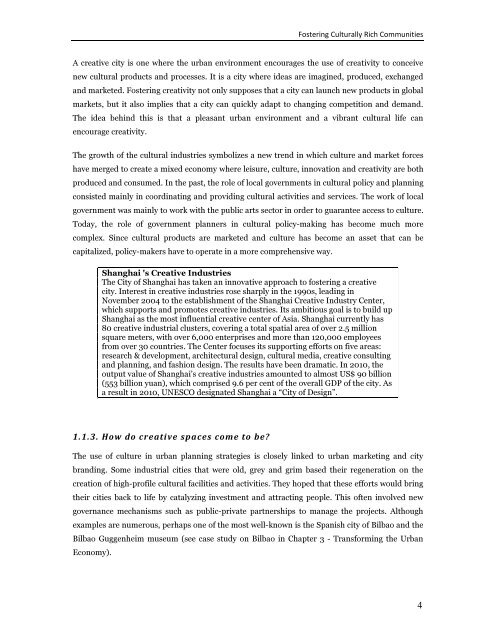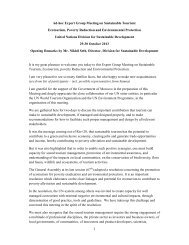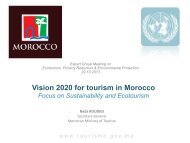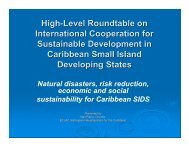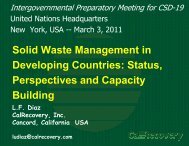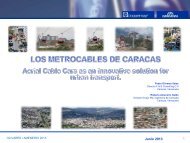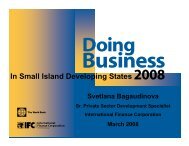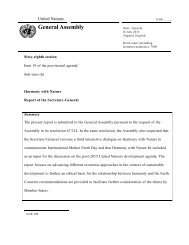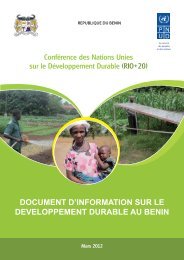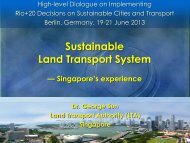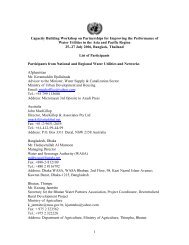A Guide for Sustainable Urban Development of the 21st Century
A Guide for Sustainable Urban Development of the 21st Century
A Guide for Sustainable Urban Development of the 21st Century
You also want an ePaper? Increase the reach of your titles
YUMPU automatically turns print PDFs into web optimized ePapers that Google loves.
Fostering Culturally Rich CommunitiesA creative city is one where <strong>the</strong> urban environment encourages <strong>the</strong> use <strong>of</strong> creativity to conceivenew cultural products and processes. It is a city where ideas are imagined, produced, exchangedand marketed. Fostering creativity not only supposes that a city can launch new products in globalmarkets, but it also implies that a city can quickly adapt to changing competition and demand.The idea behind this is that a pleasant urban environment and a vibrant cultural life canencourage creativity.The growth <strong>of</strong> <strong>the</strong> cultural industries symbolizes a new trend in which culture and market <strong>for</strong>ceshave merged to create a mixed economy where leisure, culture, innovation and creativity are bothproduced and consumed. In <strong>the</strong> past, <strong>the</strong> role <strong>of</strong> local governments in cultural policy and planningconsisted mainly in coordinating and providing cultural activities and services. The work <strong>of</strong> localgovernment was mainly to work with <strong>the</strong> public arts sector in order to guarantee access to culture.Today, <strong>the</strong> role <strong>of</strong> government planners in cultural policy-making has become much morecomplex. Since cultural products are marketed and culture has become an asset that can becapitalized, policy-makers have to operate in a more comprehensive way.Shanghai 's Creative IndustriesThe City <strong>of</strong> Shanghai has taken an innovative approach to fostering a creativecity. Interest in creative industries rose sharply in <strong>the</strong> 1990s, leading inNovember 2004 to <strong>the</strong> establishment <strong>of</strong> <strong>the</strong> Shanghai Creative Industry Center,which supports and promotes creative industries. Its ambitious goal is to build upShanghai as <strong>the</strong> most influential creative center <strong>of</strong> Asia. Shanghai currently has80 creative industrial clusters, covering a total spatial area <strong>of</strong> over 2.5 millionsquare meters, with over 6,000 enterprises and more than 120,000 employeesfrom over 30 countries. The Center focuses its supporting ef<strong>for</strong>ts on five areas:research & development, architectural design, cultural media, creative consultingand planning, and fashion design. The results have been dramatic. In 2010, <strong>the</strong>output value <strong>of</strong> Shanghai’s creative industries amounted to almost US$ 90 billion(553 billion yuan), which comprised 9.6 per cent <strong>of</strong> <strong>the</strong> overall GDP <strong>of</strong> <strong>the</strong> city. Asa result in 2010, UNESCO designated Shanghai a “City <strong>of</strong> Design”.1.1.3. How do creative spaces come to be?The use <strong>of</strong> culture in urban planning strategies is closely linked to urban marketing and citybranding. Some industrial cities that were old, grey and grim based <strong>the</strong>ir regeneration on <strong>the</strong>creation <strong>of</strong> high-pr<strong>of</strong>ile cultural facilities and activities. They hoped that <strong>the</strong>se ef<strong>for</strong>ts would bring<strong>the</strong>ir cities back to life by catalyzing investment and attracting people. This <strong>of</strong>ten involved newgovernance mechanisms such as public-private partnerships to manage <strong>the</strong> projects. Althoughexamples are numerous, perhaps one <strong>of</strong> <strong>the</strong> most well-known is <strong>the</strong> Spanish city <strong>of</strong> Bilbao and <strong>the</strong>Bilbao Guggenheim museum (see case study on Bilbao in Chapter 3 - Trans<strong>for</strong>ming <strong>the</strong> <strong>Urban</strong>Economy).4


